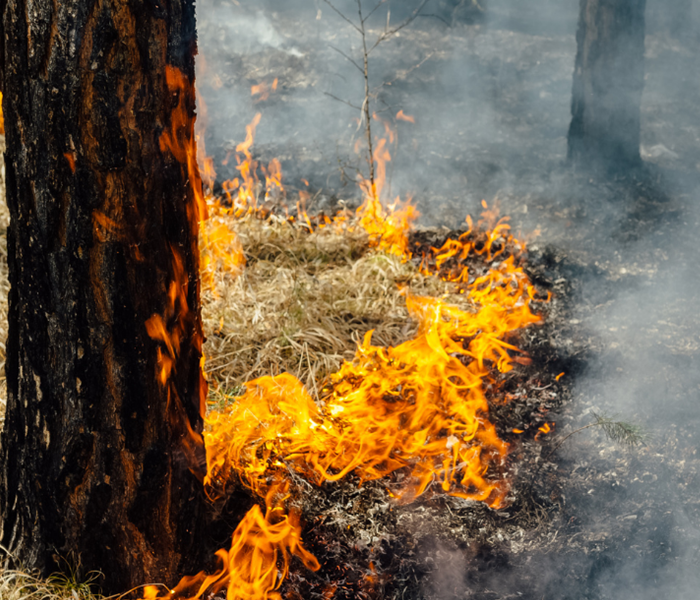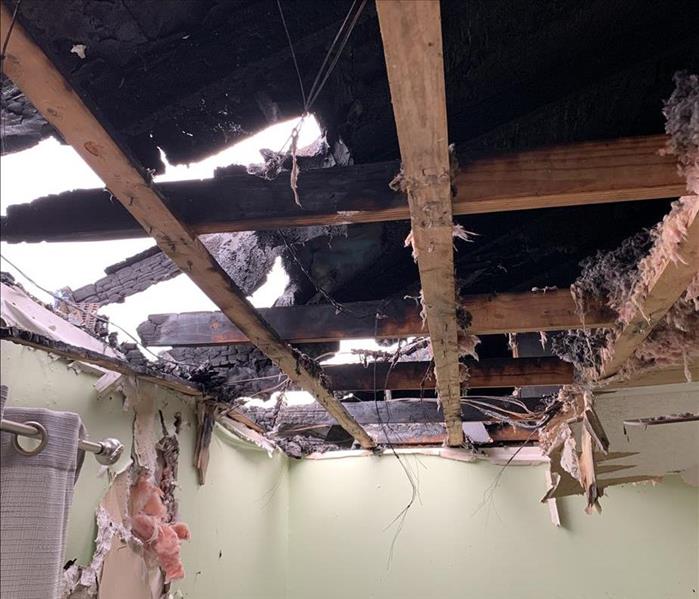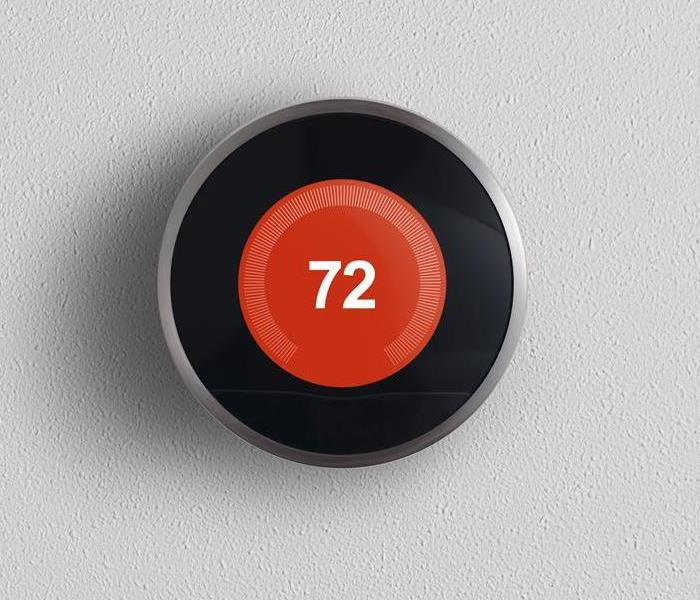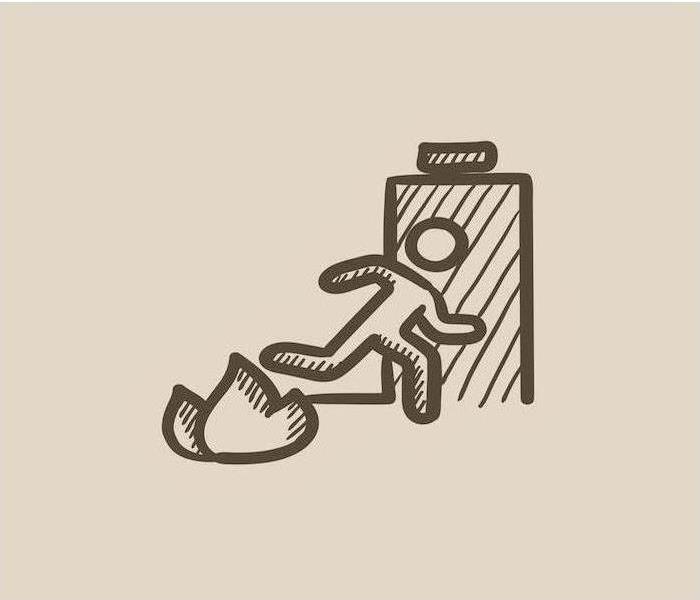Recent Fire Damage Posts
Exploding Microwave Cause of Fire Damage in Celebration Home?
3/5/2024 (Permalink)
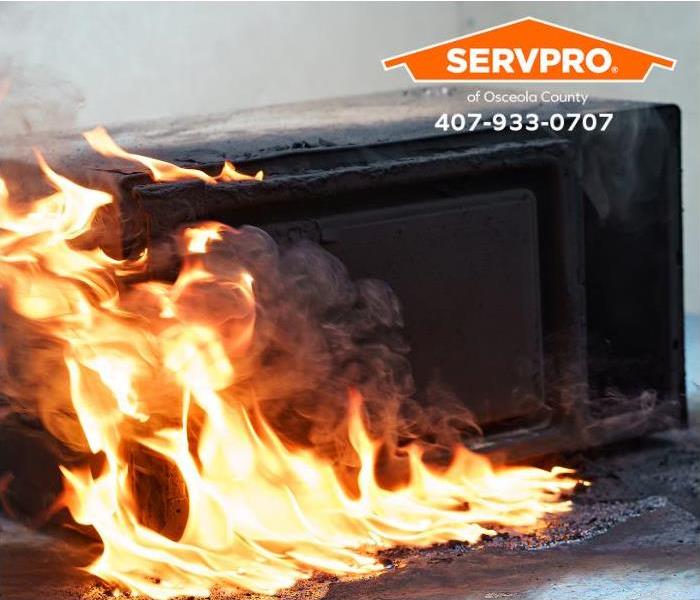 We are leaders in fire damage restoration services in Osceola County.
We are leaders in fire damage restoration services in Osceola County.
Our local Osceola County team responds to fire damage emergencies 24 hours a day in Celebration. Microwave ovens make it easy to warm up or defrost a meal, but they can cause burns and fires. Here are some microwave safety tips from the National Fire Protection Association:
- PURCHASE a microwave oven that is listed by a qualified testing laboratory. Make sure to complete and return the product registration card. This way, the manufacturer can reach you if there is a recall of the product.
- PLUG the microwave oven directly into the wall outlet — never use an extension cord.
- MAKE sure the microwave oven is at a safe height, within easy reach of all users.
- OPEN food slowly, away from the face. Hot steam or the food itself can cause burns.
- FOOD heats unevenly in microwave ovens. Stir and test before eating or giving to children.
- NEVER heat a baby bottle in the microwave. Since a microwave oven heats unevenly, it can create hot pockets, leading to burns. Warm a bottle in a bowl of warm, not hot or boiling, water, or by running it under the tap.
Call Us Today!
When your home or commercial business in Celebration has fire damage, our local Osceola County team will restore the damage “Like it never even happened.” Call us today at 407-933-0707.
SERVPRO® franchises are independently owned and operated.
Smoke Odor and Residue Cleaning Services in Holopaw?
2/13/2024 (Permalink)
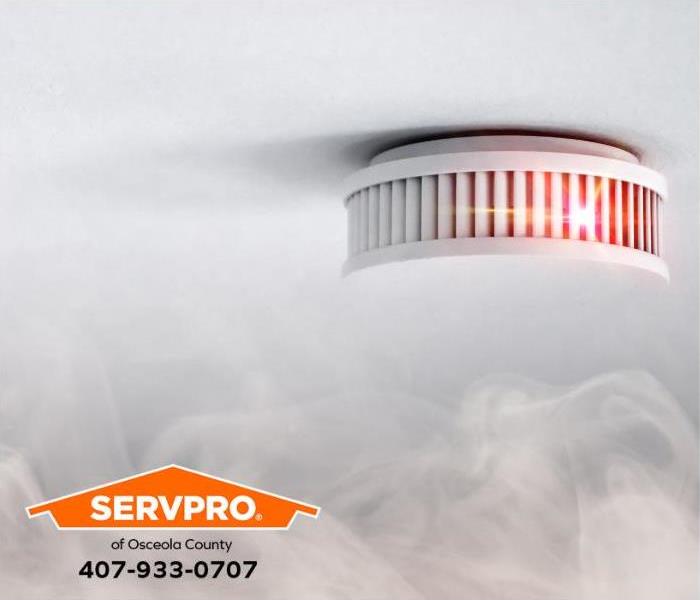 We restore smoke damage in Osceola County.
We restore smoke damage in Osceola County.
Our local Osceola County team is highly trained and certified to restore smoke damage in homes and businesses in Holopaw. Professional cleaning services are essential for removing smoke odor and residue from a fire-damaged property due to the complex and hazardous nature of the aftermath.
When a fire occurs, it releases a mixture of toxic chemicals and particles into the air, which can settle on surfaces throughout the property. These residues include soot, ash, and carcinogenic substances.
Our technicians have the specialized training and equipment to assess the damage's extent accurately. They can identify areas where smoke and residue have infiltrated, including hidden spaces, which are often missed by untrained individuals.
Additionally, smoke odor can be persistent and challenging to eliminate without professional help. We use advanced techniques like thermal fogging and ozone treatment to neutralize odors at their source. We never “mask” odors temporarily.
DIY attempts to clean fire-damaged properties can exacerbate the problem by spreading residue or causing structural damage. Professional services ensure a thorough, safe, and efficient cleanup process, minimizing the risk of secondary damage and health issues.
Call Us Today!
When your home or commercial business in Holopaw has smoke odor and residue damage, our local Osceola County team will restore the damage “Like it never even happened.” Call us today at 407-933-0707.
SERVPRO® franchises are independently owned and operated.
Space Heater Safety Tips for Lake Marian Highlands Residents?
2/6/2024 (Permalink)
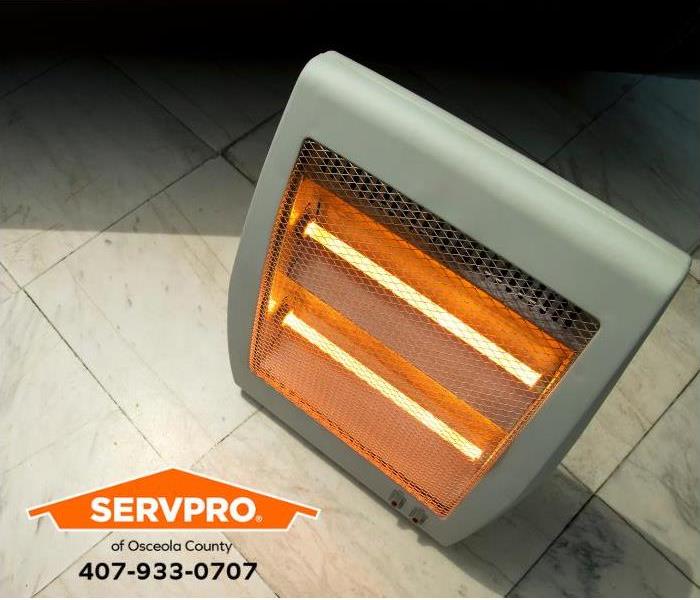 We respond to fire damage emergencies 24 hours a day in Osceola County.
We respond to fire damage emergencies 24 hours a day in Osceola County.
Our local team in Osceola County is a leader in fire damage restoration services in Lake Marian Highlands. According to the National Fire Protection Association (NFPA), space heaters were responsible for the highest proportion of losses in home heating equipment fires. During the cool winter nights, space heaters are used to warm rooms, but they can also be a fire hazard. Here are some tips from the NFPA for operating space heaters safely:
Heater Checklist
- Purchase a heater with the seal of a qualified
testing laboratory.
- Keep the heater at least 3 feet away.
from anything that can burn, including people.
- Choose a heater with a thermostat and overheat
Protection.
- Place the heater on a solid, flat surface.
- Make sure your heater has an auto shut-off to turn
the heater off if it tips over.
- Keep space heaters out of the way of foot traffic.
Never block an exit.
- Keep children away from the space heater.
- Plug the heater directly into the wall outlet.
Never use an extension cord.
- Space heaters should be turned off and
unplugged when you leave the room or go to bed
Call Us Today!
When your home or commercial business in Lake Marian Highlands needs fire damage restoration services, our local Osceola County team will restore your fire damage “Like it never even happened.” Call us today at 407-933-0707.
SERVPRO® franchises are independently owned and operated.
Family Pet Starts Fire in Poinciana Home?
1/3/2024 (Permalink)
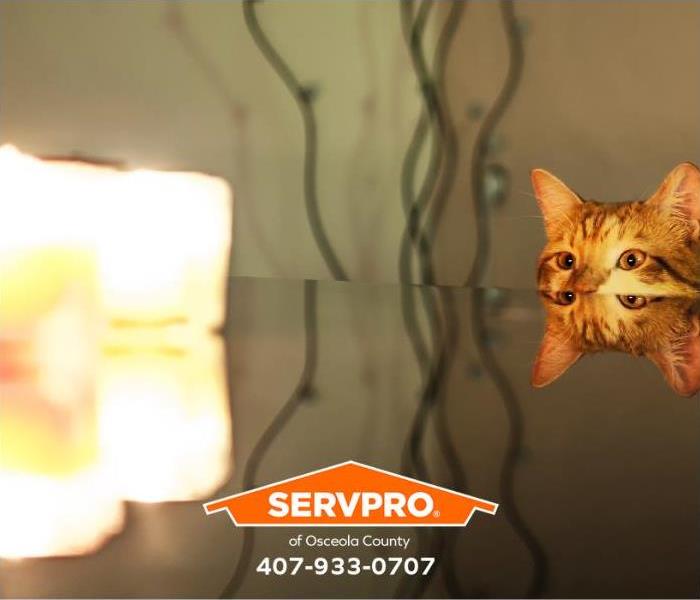 We are leaders in fire damage restoration services in Osceola County.
We are leaders in fire damage restoration services in Osceola County.
Do you know that your pet could start a fire by bumping into or knocking over a lit candle? Pets are curious and can cause fires. SERVPRO® of Osceola County responds to fire damage emergencies throughout the year in Poinciana. According to the National Fire Protection Association (NFPA), pets and wild animals play a role in starting over 750 home fires each year.
Here are some pet fire safety tips from the NFPA to keep your pets safe around fire:
- Keep pets away from stoves and countertops
- Keep pets away from candles, lamps, and space heaters
- Always use a metal or heat-tempered glass screen on a fireplace and keep it in place
- Keep pets away from a chimney’s outside vents
- Have a “pet-free zone” of at least three feet away from the fireplace. Glass doors and screens can stay dangerously hot for several hours after the fire goes out.
- Some pets are chewers. Watch pets to make sure they don’t chew through electrical cords. Have any problems checked by a professional.
Call Us!
When your home or commercial business in Poinciana needs fire damage restoration services, our local Osceola County team will restore your fire damage “Like it never even happened.” Call us today at 407-933-0707.
SERVPRO® franchises are independently owned and operated.
Cleaning Up Smoke and Soot After a Fire
3/22/2023 (Permalink)
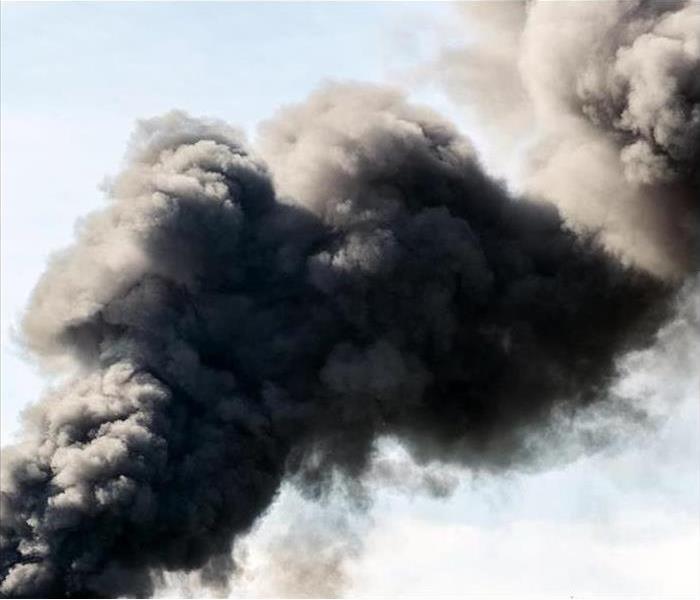 What type of doot damage are you dealing with?
What type of doot damage are you dealing with?
Understanding the Types of Smoke Damage
Knowing what kind of smoke has impacted your home can help determine the most effective cleaning method. Here are three common types of smoke damage:
Wet Smoke
- Produced by slow-burning, low-heat fires.
- Commonly caused by burning plastic or rubber.
- Leaves behind a sticky, thick residue that’s challenging to clean.
Dry Smoke
- Results from fast-burning, high-heat fires.
- Often caused by wood or paper fires.
- Leaves a powdery residue that can spread easily.
Protein Residue
- Comes from the evaporation of organic materials, such as food.
- Not technically smoke, but it leaves behind strong, foul odors.
- Typically invisible, but it can cling to surfaces and appliances.
Identifying the type of smoke damage can guide the cleaning and restoration process for better results.
Why Immediate Action Is Crucial
Delaying smoke damage cleanup can lead to:
- Increased Damage: Smoke and soot are corrosive, and prolonged exposure can permanently damage surfaces, fabrics, and electronics.
- Embedded Residue: Movement in the area can push soot deeper into upholstery, carpets, and other porous materials, making it harder to clean and restore.
- Lingering Odors: The longer smoke and soot remain untreated, the harder it becomes to eliminate the smell.
Quick action helps preserve your home and belongings while reducing restoration costs.
Effective Smoke Cleaning Options
There are several advanced techniques available for smoke and soot removal:
Air Scrubbing
- Filters out smoke particles from the air using specialized equipment.
- Commercial-grade scrubbers are more effective than residential models at removing lingering smoke.
Thermal Fogging
- Heats surfaces in your home to expand them, allowing deodorizing agents to penetrate deeply.
- Ideal for neutralizing odors embedded in walls, ceilings, and furniture.
Ozone Treatment
- Releases ozone to oxidize smoke particles, effectively neutralizing unpleasant odors.
- A powerful option for restoring air quality in your home.
Ultrasonic Cleaning
- Uses ultrasound waves and a cleaning solution to thoroughly clean and restore delicate or heavily contaminated items.
- Particularly effective for soot-covered belongings like electronics, ceramics, and glassware.
Trust the Experts for Restoration
No matter the type of smoke damage, professional restoration teams have the tools and expertise to choose the best cleaning method for your home. They can ensure that your property and belongings are restored as closely as possible to their pre-fire condition.
By acting quickly and seeking professional help, you can minimize damage and return your home to normal faster. Don’t wait—reach out to a trusted restoration service today.
Home Candle Safety Tips
7/29/2022 (Permalink)
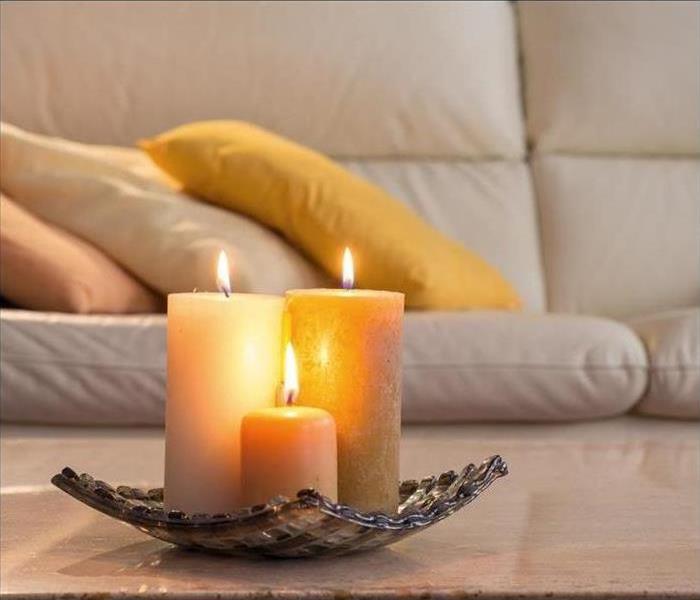 Candle safety tips for your Florida home.
Candle safety tips for your Florida home.
Each year, a number of candle fire mishaps occur in households in Florida, and across the U.S., leading to injuries, structural damage and the need for professional restoration and smoke cleanup. It's important to know how to properly use candles in your home and avoid a possible mishap. Here are some tips for candle safety.
1. Keep Candles and Matches in a Safe Place
Make sure any lit candle is well away from any areas accessible by children or pets, as it's easy for them to knock over a candle that's sitting out on a low table or shelf. Also avoid candle fires by safely storing matches, lighters and candles in a cabinet that kids can't get to.
2. Place Candles Securely
Candles should be placed on a sturdy surface in an area that's uncluttered. Make sure that the candle is at least a foot away from anything that might catch fire. When using a candle holder, make sure it has a stable base and can't be easily tipped over. Also make sure you have several different sizes of candle holders on hand, and that you put the candles on a heat-resistant surface.
3. Be Aware
Never leave a candle burning in a room without keeping an eye on it. Leaving candles unattended can lead to disaster. Make sure to watch the airflow around the candle. If the flame is constantly shifting direction, move it to a place where the flame stays stable.
4. Burn Candles Safely
When lighting candles, make sure to keep your hair out of the way, and keep the flame well away from any loose clothing. If a candle is down to the last inch or so, put it out and throw it away. Don't allow it to burn down close to the candle holder. Never use candles if someone in the house is using an oxygen tank. Don't use candles in your bedroom. You could easily fall asleep, leaving the candle unattended and increasing the risk of a fire.
Using candles safely is easy. With the aid of these common-sense tips, you'll be able enjoy the beauty and warm glow of candles without the risk of a candle fire.
Causes of Wildfires
7/25/2022 (Permalink)
Wildfires are growing rapidly through the state of Florida and effecting our own communities and homes. Many believe the causes of these wildfires are the lack of rain Florida has had this spring, which is definitely a factor, but not the only one. Humans are actually one of the leading factors in these occurring wildfires even though we, Floridians are in a drought. In the United States, 90% of wildfires are caused by humans. What are we, as a society, doing to cause acres upon acres of burning?
- When cooking with fire on a grill or over a campfire, people are not taking the right precautions, whether that is not making sure all debris around the fire is clear or keeping a close eye on the fire or leaving it unattended.
- Some smokers are negligently discarding cigarettes or cigars, and in dry weather are unintentionally igniting debris or leaves.
- Children playing with fireworks, matches, or lighters.
- People who are intentionally participating in acts of arson.
- Equipment malfunctioning such as vehicles, tractors, yard equipment that uses gas, garage tools, etc.
- The burning of trash in yards or on large properties. These fires can easily spread by burning ashes or leaves or debris close to the fire.
Florida's Extreme Heat Safety Tips
7/25/2022 (Permalink)
As summer approaches, it is time to consider safety precautions for extreme heat in the coming months in Central Florida. Heat affects all people, but especially the young, elderly, sick, and overweight. As Florida residents, we have a greater chance of being chance of being affected due to the high temperatures and humidity. There are several things you can do to prepare for and prevent extreme heat from affecting you and your family.
Prepare Your Home
- Install windows air conditioners snugly; insulate if necessary.
- Check air-conditioning ducts for proper insulation.
- Install temporary window deflectors (for use between windows and drapers), such as aluminum foil-covered cardboard, to reflect heat back outside.
- Weather-strip doors and sills to keep call air in. This can also help keep your electric bill down in the summer months.
- Cover windows that receive morning or afternoon sun with drapes, shades, awnings, or louvers. (Outdoor awning or louvers can reduce the heat that enters a home by up to 80 percent.)
- Keep storm windows up all year.
Prepare Yourself Before Going Outside
- Wear loose-fitting, light-colored clothing
- Be sure to apply sunscreen
- Wear sunglasses
- Stay hydrated and limit alcohol and caffeine intake on those days.
- Be aware and pay attention to signs of Heat exhaustion
If possible, limit your time outside on extremely hot days and stay indoors in the air conditioning. Be sure to check on your pets who may be outdoors or bring them inside. Staying hydrated will help you from experiencing heat exhaustion. Heat exhaustion can lead to heat stroke, which is life- threatening. Signs of heat stroke are high body temperature (103+), rapid and strong pulse, and possible unconsciousness.
DID YOU KNOW? On average, heat is the number one weather-related killer in the United States.
About your local SERVPRO of Osceola County in Central Florida
SERVPRO of Osceola County specializes in fire, water, and mold remediation. Our highly trained technicians are restoration professionals that use specialized equipment and techniques to properly remediate your home quickly and safely. We service the residents of St. Cloud, Kissimmee, Celebration, Four Corners, and Champions Gate. Contact our office staff if you have any questions about water or mold damage in you home or business area. Schedule a FREE Assessment at 407-933-0707
How To Secure Damaged Roofs and Other Problems After a Fire
4/24/2022 (Permalink)
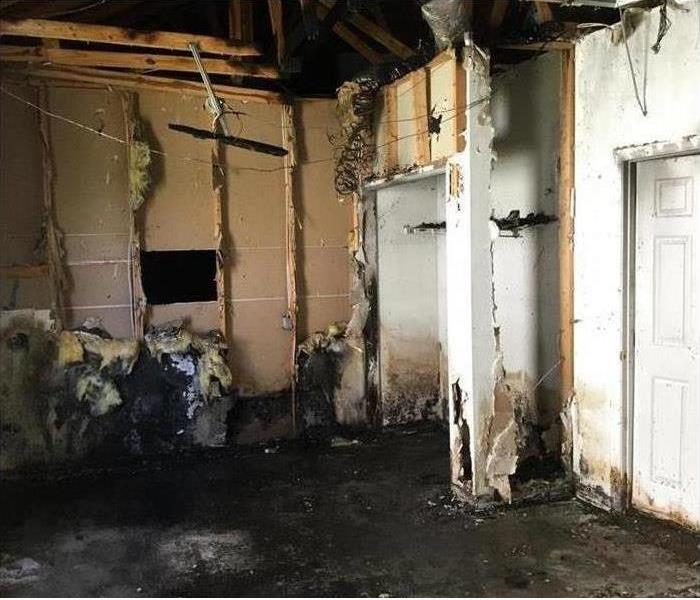 Interior of a home ravaged by fire in Celebration, FL
Interior of a home ravaged by fire in Celebration, FL
A fire in your home or in a commercial building can lead to a variety of problems and delays. A fire restoration company can take care of these problems and prevent new ones from occurring, but what happens if the structure is severely damaged? Here are three things you can do to prevent further damage while you are waiting for the full restoration of your home or office.
1. Cover Any Openings
Often, fires can damage the walls and roof of any structure, causing them to cave in and expose the interior rooms to the outside world. Roof repair may take a while to complete. To prevent further damage from rain, wind, or other outside conditions, consider covering any openings with tarps. Your professional restoration company may offer tarp services, or you can purchase some supplies from a local appliance store.
Using tarps to secure all openings is a quick, easy fix that can save time and money in the future. Once all holes are covered, you can wait for fire cleanup services, to permanently fix the openings.
2. Secure Your Building
If your home or office was severely damaged in a fire, you might have temporarily relocated. However, it’s still important to secure the damaged structure to avoid any break-ins or other unpleasant situations. You may want to board up easily-accessed windows with plywood. Another great way to secure your property is to add stronger locks to all doors that enter the property.
3. Protect Valuable Equipment
If you can re-enter the property after the fire, salvage all equipment that is important or vital to you. Soot and smoke from the fire can permanently damage objects if they are not treated. While you are waiting for fire cleanup, you may want to clean and protect affected items.
By doing these three things, you can take care of your property and prevent further damage. Once fire cleanup services come and repair the damage, you can be assured that your building will be completely restored. Call SERVPRO of Osceola County, for all of your fire restoration needs 407-933-0707.
Fire Damage: Who Pays for What in a Rental Situation?
3/16/2022 (Permalink)
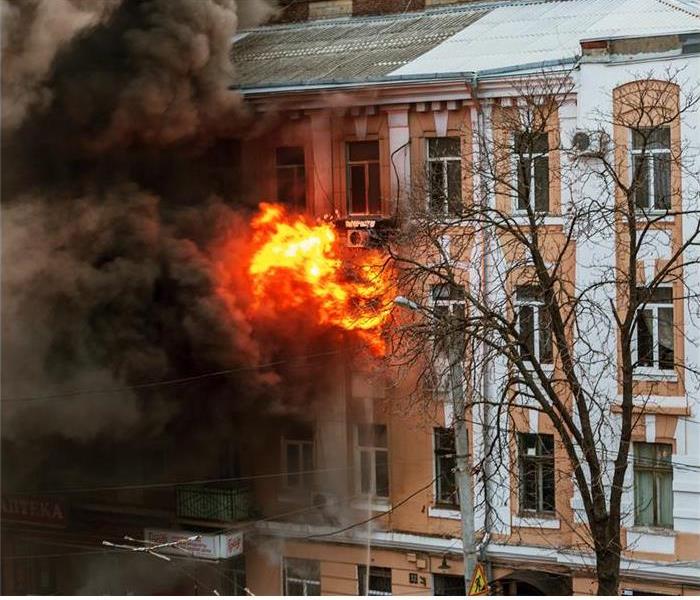 An apartment fire in Poinciana, FL
An apartment fire in Poinciana, FL
Going through an apartment fire can be tough on both the tenant and the landlord, if in different ways. With tensions high, it can be more difficult to calmly discuss who is responsible for repairs. Before this happens to you in Poinciana, FL, educate yourself.
Assess the Damage
From the very beginning, the tenant and the landlord should be working together. It's generally a good idea to follow these steps:
Both landlord and tenant should call their own insurance.
As soon as it's been deemed safe by the fire officer, both should do a walk-through to catalogue the fire damage: written lists, pictures and receipts.
The landlord should take the lead on securing the property, like laying tarp over any exposed areas and locking it down.
Both should agree on a fire remediation service, like SERVPRO of Osceola County.
Structural Damage
After an apartment fire, the responsibility of the landlord is to the bones of the property, unless otherwise stated in a lease agreement. Structural damage can include walls, windows, roofing, electrical, plumbing, cabinets and countertops- basically everything that existed before the tenant's arrival. Usually the landlord won't be paying out of pocket, it will be through their insurance policy.
Content Damage
The tenant is only responsible for all of their personal property, like furniture, electronics, documents and clothing. If they have the appropriate coverage, this could also be paid for through their renter's policy. Insurance could also cover temporary housing while the property is rehabilitated. If the landlord and tenant have been coordinating, the same fire remediation service can handle both the content and structural damage.
An apartment fire involves a lot of interested parties. It's a good idea to get a handle on who is taking care of what before moving forward. That way, everything can get done faster and everyone can get back to living their lives. Team work makes the dream work!
14 Bad Habits That Could Burn Down Your Home
2/16/2022 (Permalink)
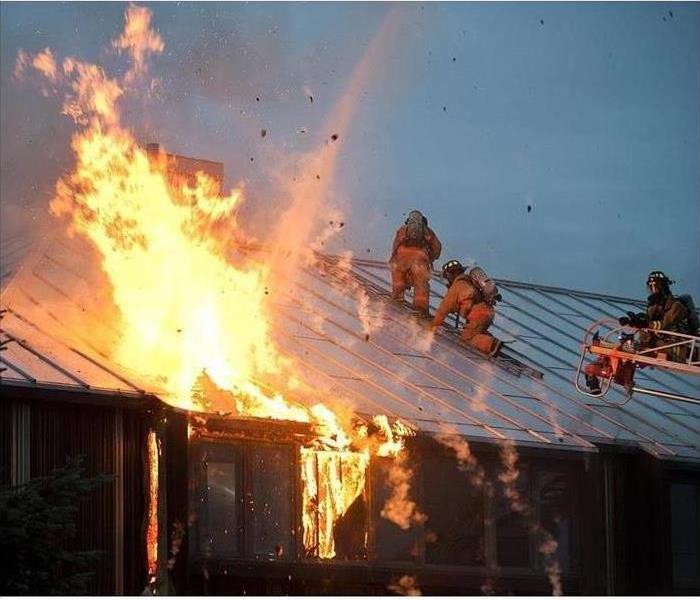 Electrical fires can occur rapidly and takes minutes to burn down your home.
Electrical fires can occur rapidly and takes minutes to burn down your home.
As busy homeowners, fire prevention has taken a back seat on our list of priorities creating bad habits. House fires are becoming more and more frequent due to common bad habits that can quickly become a fire hazard. Without you realizing it, these potential fire starters are hiding in plain sight throughout your home.
For instance forgetting to take the time to change a dull light bulb or leaving an abundant amount of lint in your dryer. Our mind disguises these simple tasks as harmless, when in reality, it can become quite devastating.
1. Piling up dirty, oily rags - If left sitting, these rags could oxidize and spontaneously combust.
2. Misusing electric blankets - If heat starts to buildup or the coils bend the wrong way, the electrical blanket can catch on fire.
3. Neglecting appliance recalls - Last year defective appliances caused 150,000 fires.
4. Lingering dryer lint - The combination of lint buildup and excessive heat creates fire.
5. Letting your laptop overheat - If the cooling vent airflow is restricted, the laptop can overheat and catch on fire.
6. Choosing the wattage - Using the wrong wattage of a light bulb can initiate an electrical fire.
7. Using too many extension cords - This can create an overload leading to a short circuit, which produces a fire.
8. Performing DIYs you’re not qualified to do - Electrical wiring, plumbing, and HVAC mistakes can easily ignite fires.
9. Disregarding dust - Dust buildup around electronics and electronic sockets can become a fire hazard.
10. Storing batteries improperly - If the battery’s terminals make contact with other metals (screws, papers clips, etc.), it can short out the battery producing enough heat to possibly catch flammable material on fire.
11. Ignoring mice or other rodents - These animals are known for chewing on electrical wires, which removes the sheathing and exposes the heated wiring. This can lead to sparking surrounding surfaces caused by short circuiting, resulting in igniting a fire.
12. Forgetting the chimney sweep - Chimney fires are commonly cause by buildup of creosote, dead animals (usually birds or raccoons), and cracked mortar.
13. Overlooking the range hood - Grease and other cooking buildup that’s left on the vent hood filter can drip down on the stovetop, catching the fallen material on fire.
14. Arranging furniture unwisely - Furniture can unexpectedly ignite, if you position it by a source of heating such as a fireplace, wood stove, or space heater.
Have A Professional Clean Smoke Damage After A Fire
1/3/2022 (Permalink)
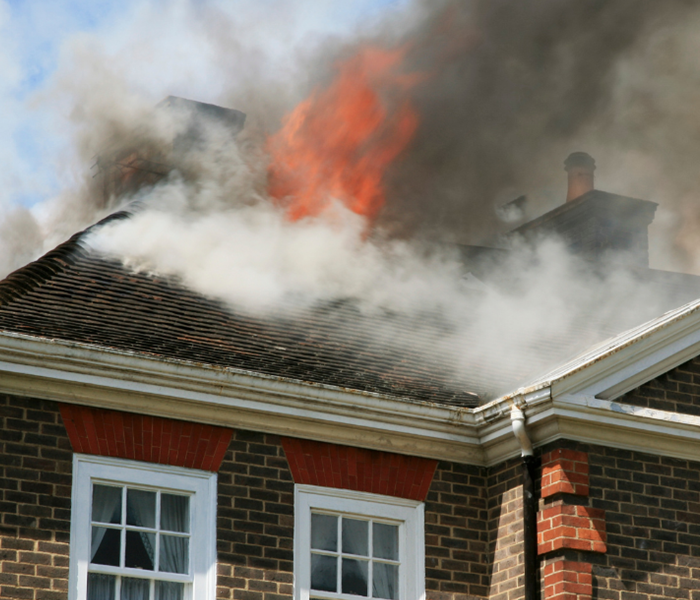 It only takes a few seconds for a fire to wreak havoc on a commercial property or home.
It only takes a few seconds for a fire to wreak havoc on a commercial property or home.
It only takes a few seconds for a fire to wreak havoc on a commercial property or home. The first thing that one will want to do if there is a fire is call the fire department to extinguish the fire. Many people believe that they can re-enter the property and begin restoring it after a fire. However, there are still threats that linger for the property. That is it is best to hire a professional fire restoration company like, SERVPRO of Osceola County.
The Aftermath Of A Fire
Many people believe that once the fire has been put out, the danger is no longer present. However, fire leaves behind remnants that can cause serious damage to the property. The smoke and ash that is left behind cause discoloration, etching and a very unpleasant odor. The building will be less likely to suffer those problems if you SERVPRO.
The Sooner You Call, The Better
It is best to contact a fire restoration company, like SERVPRO of Osceola County, as soon as possible in order to restore the fire damages. Ash is one of the major concerns. It can discolor just about anything that it comes in contact with. Discoloration can begin just a few hours after the fire. Fiberglass, plastic and other finishes can turn yellowish. Metals will start to tarnish. You will have to replace or refinish certain items in your home after a few days because the damage will be permanent.
Hiring A Fire Restoration Contractor
If you have hired a certified and trained professional from SERVPRO, then they will be at your home in a short amount of time. They will assess the home in order to see the type of damage that is done. They will also perform a thorough cleaning in order to remove the ash, smoke and other fire damages. Items that are beyond repair will be removed, and specialized cleaning supplies will be used to neutralize odors.
Do-it-yourself techniques typically do not remove the smoke and ash that is left behind by a fire. You may cause further damage and contamination to your home if the correct techniques are not used. That is it is best to contact SERVPRO of Osceola County, so that they can perform the needed restoration.
Fire Safety Equipment: Five Pieces You Need for Your Home
6/30/2021 (Permalink)
Our homes may be our sanctuaries, but they also present multiple opportunities for fire danger. An unattended stovetop can result in a kitchen fire, while electrical systems and appliances can overheat. Fireplaces, candles, flammable liquids, and outdoor grills — to name just a few — all add to the risk.
Having the correct fire safety equipment in your house is essential to keep your family safe and your home protected. This article highlights the five most important pieces of equipment needed to safeguard your home and loved ones. The peace of mind that comes from knowing you’re prepared is worth the time, effort, and expense involved.
Smoke Alarms
This is your first line of defense. According to the Red Cross, the National Fire Alarm Code (NFPA 72) requires all new homes to have inter-connected hard-wired smoke alarms with battery backup. If you don’t have an interconnected system, battery-powered alarms are easily installed. Both types of alarms need to be located on every level of the home with one inside each bedroom.
Fire Extinguishers
Since most home fires start in the kitchen, you’ll want to put a fire extinguisher in there, at a minimum. But it’s recommended to place them in multiple locations around the house. Since extinguishers from various makers all work differently, it’s a good idea for the adults in the household to get training from the local fire department. Extinguishers should be installed near exits, away from heat sources, and up high enough that kids can’t reach them.
Sprinkler Systems
While a smoke alarm will detect smoke, an automatic sprinkler system gives you a way of dealing with flames immediately. While you’re waiting on the fire department to arrive, sprinklers can help slow a fire’s progress or can even douse it completely. Moreover, a sprinkler system can prevent deadly gases and smoke from affecting your family and could also extinguish a fire that breaks out while you’re away from home.
Carbon Monoxide Alarms
There’s a good reason carbon monoxide (CO) is called the “silent killer.” This deadly gas is invisible, odorless, and colorless and even a small amount can be fatal if inhaled for long enough. Install carbon monoxide alarms on each level of your home and outside bedrooms. If the alarm emits its high-pitched warning, get outside as quickly as possible or open windows and doors and take deep breaths of fresh air. CO poisoning can cause headaches, nausea, and tiredness and can be mistaken for flu.
Fire Escape Ladders
If your home has more than one floor, collapsible fire ladders should be a part of your fire-safety arsenal. Place a ladder where it’s easy to access in every upper-level room in case your evacuation route gets cut off by smoke or fire. Then, have the entire family rehearse the steps they would take to get the ladders out and attached to open windows.
No one wants to dwell on the possibility of their family being in danger or their home being consumed by flames, but this is one situation where being properly prepared could save lives and property. If you haven’t already done so, make an escape plan and go over it with your family. And check your homeowner’s insurance to make sure your policy is up to date with adequate coverage.
Home Electrical Fires
6/11/2021 (Permalink)
When a fire in a home happens we always blame it on a item we forgot to turn off. Did you know most of the time that is not the case. Here are some facts about home electrical fires.
Electrical Fire Facts
In 2014-2018, electrical distribution or lighting equipment, such as wiring, lighting, cords, and plugs, was involved in an estimated average of roughly 34,000 (10%) reported home structure fires per year. These incidents caused an average of 470 (18%) civilian deaths, 1,100 civilian injuries (10%), and $1.4 billion (19%) in direct property damage annually.
Electrical distribution or lighting equipment ranked first in direct property damage, and third among the major fire causes in the number of home fires, fourth in home fire deaths, and tied for third in home fire injuries.
Wiring and related equipment accounted for 7 percent of all home fires and nine percent of all home fire deaths.
Cords or plugs were involved in only one percent of home fires but seven percent of the deaths. Extension cords dominated the cord or plug category.
Source: NFPA's Applied Research Department
NFPA - Fire Prevention
If you had a home electrical fire call SERVPRO of Osceola County.
Our professional teams can help you feel "Like it never even happened."
#SERVPROOsceolaCounty #electricalfirefacts #nfpa #firecleanupandrestoration
Unattended Cooking Fires
4/16/2021 (Permalink)
Did you know last year many kitchen fires were mainly caused by unattended cooking?
Here are some stats of damages caused by kitchen fires:
Cooking fire stats:
- Cooking equipment is the leading cause of home fires and fire injuries, causing 49% of home fires that resulted in 21% of the home fire deaths and 44% of the injuries.
- Two-thirds (66%) of home cooking fires start with the ignition of food or other cooking materials.
- Clothing is the item first ignited in less than 1% of these fires, but clothing ignitions lead to 8% of the home cooking equipment fire deaths.
- Ranges or cooktops account for three-fifths (61%) of home cooking fire incidents.
- Unattended equipment is a factor in one-third (31%) of reported home cooking fires and over half (53%) of the associated deaths.
- Frying dominates the cooking fire problem.
Here are some tips on cooking especially with oil or frying:
What you should know about home cooking safety
- Be on alert! If you are sleepy or too tired to cook. Do not cook.
- Stay in the kitchen while you are frying, grilling, boiling, or broiling food.
- If you are simmering, baking, or roasting food, check it regularly, remain in the kitchen while food is cooking, and use a timer to remind you that you are cooking.
- Keep anything that can catch fire — oven mitts, wooden utensils, food packaging, towels, or curtains — away from your stovetop.
If you have a cooking fire
- Just get out! When you leave, close the door behind you to help contain the fire.
- Call 9-1-1 or the local emergency number after you leave.
- If you try to fight the fire, be sure others are getting out and you have a clear way out.
- Keep a lid nearby when you’re cooking to smother small grease fires. Smother the fire by sliding the lid over the pan and turn off the stovetop. Leave the pan covered until it is completely cooled.
- For an oven fire, turn off the heat and keep the door closed.
Safety considerations for cooking with oil
- Always stay in the kitchen when frying on the stovetop.
- Keep an eye on what you fry. If you see wisps of smoke or the oil smells, immediately turn off the burner and/or carefully remove the pan from the burner.
- Smoke is a dangerous sign that the oil is too hot.
- Heat the oil slowly to the temperature you need for frying or sautéing.
- Add food gently to the pot or pan so the oil does not splatter.
- Always cook with a lid beside your pan. If you have a fire, slide the lid over the pan and turn off the burner. Do not remove the cover because the fire could start again. Let the pan cool for a long time. Never throw water on the fire.
- If the fire does not go out or you don’t feel comfortable sliding a lid over the pan, get everyone out of your home. Call the fire department from outside
After the fire calls us we are open 24/7 and we are there when you need us the most.
#kissimmeefirecleanup #saintcloudfl #kitchenfireemergencycleanup #sootremoval
Prevent a kitchen fire
1/26/2021 (Permalink)
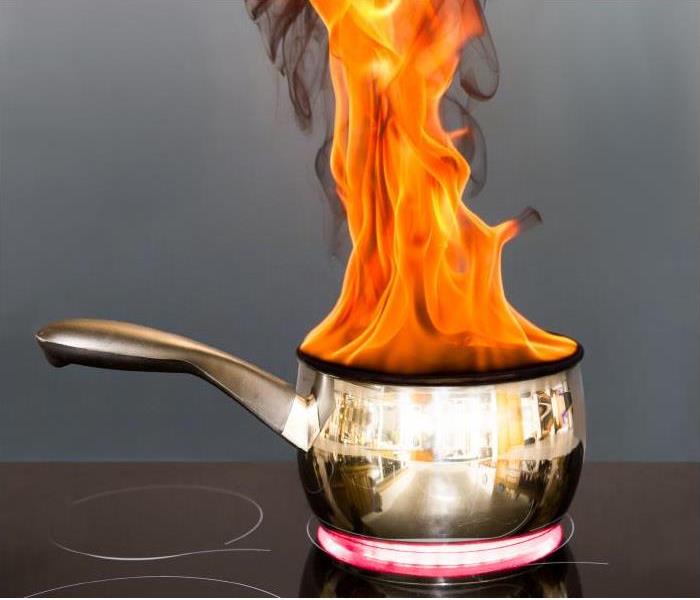 Unattended pot on fire on a stovetop
Unattended pot on fire on a stovetop
Did you know last year many kitchen fires were mainly caused by unattended cooking?
Here are some stats of damages caused by kitchen fires:
Cooking fire stats:
- Cooking equipment is the leading cause of home* fires and fire injuries, causing 49% of home fires that resulted in 21% of the home fire deaths and 44% of the injuries.
- Two-thirds (66%) of home cooking fires start with the ignition of food or other cooking materials.
- Clothing is the item first ignited in less than 1% of these fires, but clothing ignitions lead to 8% of the home cooking equipment fire deaths.
- Ranges or cooktops account for three-fifths (61%) of home cooking fire incidents.
- Unattended equipment is a factor in one-third (31%) of reported home cooking fires and over half (53%) of the associated deaths.
- Frying dominates the cooking fire problem.
Here are some tips on cooking especially with oil or frying:
What you should know about home cooking safety
- Be on alert! If you are sleepy or too tired to cook. Do not cook.
- Stay in the kitchen while you are frying, grilling, boiling, or broiling food.
- If you are simmering, baking, or roasting food, check it regularly, remain in the kitchen while food is cooking, and use a timer to remind you that you are cooking.
- Keep anything that can catch fire — oven mitts, wooden utensils, food packaging, towels, or curtains — away from your stovetop.
If you have a cooking fire
- Just get out! When you leave, close the door behind you to help contain the fire.
- Call 9-1-1 or the local emergency number after you leave.
- If you try to fight the fire, be sure others are getting out and you have a clear way out.
- Keep a lid nearby when you’re cooking to smother small grease fires. Smother the fire by sliding the lid over the pan and turn off the stovetop. Leave the pan covered until it is completely cooled.
- For an oven fire, turn off the heat and keep the door closed.
Safety considerations for cooking with oil
- Always stay in the kitchen when frying on the stovetop.
- Keep an eye on what you fry. If you see wisps of smoke or the oil smells, immediately turn off the burner and/or carefully remove the pan from the burner. Smoke is a dangerous sign that the oil is too hot.
- Heat the oil slowly to the temperature you need for frying or sautéing.
- Add food gently to the pot or pan so the oil does not splatter.
- Always cook with a lid beside your pan. If you have a fire, slide the lid over the pan and turn off the burner. Do not remove the cover because the fire could start again. Let the pan cool for a long time. Never throw water on the fire.
- If the fire does not go out or you don’t feel comfortable sliding a lid over the pan, get everyone out of your home. Call the fire department from outside
After the fire calls us we are open 24/7 and we are there when you need us the most.
#kitchenfires #kitchenfirecleanup #sootafterfire
Winter heating ways and household fires
1/11/2021 (Permalink)
Did you know that in 2018 43% of the winter home fires were due to Space heaters.
When winter hits we all try to keep warm and seek cost-efficient ways. The most common is space heaters. A space heater can be also dangerous if not attended to.
Here are some tips from the National Fire Protection Association:
- Have a three-foot “kid-free zone” around open fires and space heaters.
- Have a qualified professional install stationary space heating equipment, water heaters, or central heating equipment according to the local codes and manufacturer’s instructions.
- Have heating equipment and chimneys cleaned and inspected every year by a qualified professional.
- Always use the right kind of fuel, specified by the manufacturer, for fuel-burning space heaters.
- Make sure the fireplace has a sturdy screen to stop sparks from flying into the room. Ashes should be cool before putting them in a metal container. Keep the container a safe distance away from your home.
- Install wood burning stoves following manufacturer’s instructions or have a professional do the installation. All fuel-burning equipment should be vented to the outside to avoid carbon monoxide (CO) poisoning.
- Install and maintain CO alarms to avoid the risk of CO poisoning. If you smell gas in your gas heater, do not light the appliance. Leave the home immediately and call your local fire department or gas company.
- Never use your oven to heat your home.
If you had a fire caused by heating your home call SERVPRO of Osceola at 407-933-0707
#spaceheaterfires #SERVPROofosceola #osceloa
#spaceheatertip
Heating Your Home
12/15/2020 (Permalink)
If you have a fire in your home, SERVPRO is there to help. But we also want to help you prevent fires in your home.
Did you know that heating equipment is the leading cause of home fire deaths, according to the National Fire Protection Association (NFPA)? Cold temperatures during these winter months have led to people frequently using their heaters. Half of these heating equipment fires predictably take place in the winter months of December, January, and February when heating equipment is used the most.
Abiding by the following safety measures will keep yourself and your family safe from any potential dangers of using heaters in your home.
Stay Three Feet Away
One way to stay safe when heating your home is to keep flammable items at least three feet away from heating equipment. That includes a furnace, fireplace, wood stove, or portable space heater.
Enforce a Three-Foot Rule for Children
The curiosity of children can cause a problem if they focus their attention on one of these heating options. Wanting to explore the equipment, the child could accidentally catch on fire or start a fire in the house. Therefore it’s a good idea to have a three-foot “kid-free zone” around all open fires and space heaters.
Don’t Use Your Oven As a Heater
Never attempt to use your oven to heat your home. The inefficacy of an oven as it pertains to heating could cause it to go out or not burn well which could potentially lead to carbon monoxide poisoning endangering the lives of your whole family.
Use Only Qualified Professionals When Installing Heating Equipment
Make sure a qualified professional install your heating equipment. An inexperienced person installing your space heater, water heater, or central heating equipment could lead to serious mistakes that could cause a fire. Hiring qualified professionals will ensure that the person installing your equipment adheres to local codes and manufacturer’s instructions.
Get Your Annual Chimney Inspection
It’s important to have your heating equipment or chimney cleaned and inspected every year by a qualified professional. In early 2000, the NFPA set a new standard that ensures that inspections include a thorough inspection and cleaning. Based on the purpose of the inspection (annual inspection, system change or real estate transaction, potential hazard) the inspector will inspect on one of three levels. The thoroughness of the inspection will increase at each level of the inspection.
Never Leave Portable Heaters On When Leaving a Room
Always turn off and unplug portable heaters when leaving a room or going to bed. Portable heaters can short out while you’re away and start a fire before you return.
Make Sure to Use Correct Fuel
Use the right kind of fuel when using fuel-burning space heaters. The manufacturer will specify which fuel that specific space heater will need. Using the wrong kind of fuel could cause the fuel to burn hotter than the equipment was designed for and could cause a fire in your home.
Use a Fireplace Screen
It’s important to make sure that your fireplace has a screen in front of it. Without a screen, sparks could fly into the room and start a fire. Also, if you plan to dispose of ashes in a metal container, ashes should be cooled prior to entering a metal container. The container should also be kept a safe distance away from your home.
Test Smoke Alarms Monthly
If a fire starts in your home in Saint Cloud, a smoke alarm can save your life. Smoke spreads quickly and a properly working smoke alarm will give you enough time to get out. So make sure you test your smoke alarms each month. Also, make sure to replace your smoke detectors once every ten years.
Use Ventilation
When burning anything larger than a candle, make sure to provide good ventilation. You can do this by opening windows, doors, or fireplace fumes. Good ventilation will substantially reduce the amount of smoke that can be harmful to those in the home.
On cold days heating is a must. But without the use of certain precautions, it can be a very dangerous decision. By following the safety measures highlighted by the NFPA, you can ensure that you will be warm and safe during the cold winter months.
#heatersafety #spaceheater #righttempforhome #heatertips #SERVPROofOsceolaCounty
Is your dryer vent clean?
6/23/2020 (Permalink)
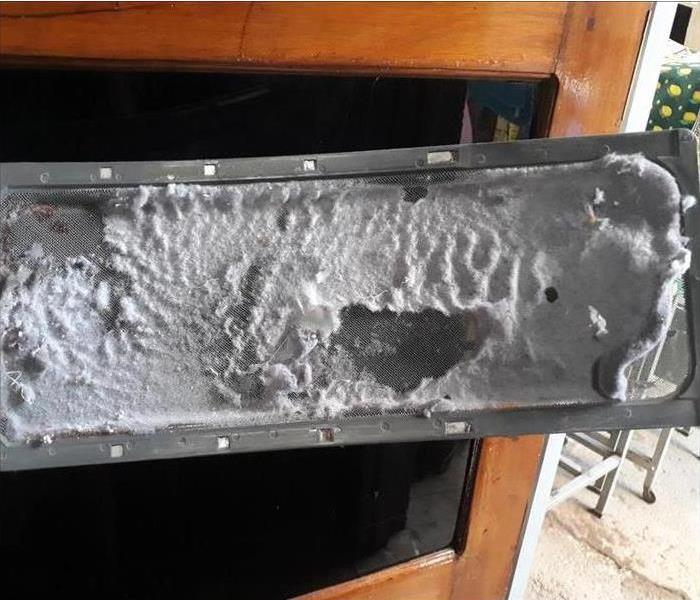 A lint fire can be a dangerous situation and cause a great deal of damage.
A lint fire can be a dangerous situation and cause a great deal of damage.
So, What Are the Signs That Your Vent Needs Cleaning?
As a homeowner in Saint Cloud, FL, you're probably very diligent about fire safety. You may have a fire extinguisher and smoke detectors on every floor, but have you checked your dryer vent lately? Many homes are damaged each year as the result of a lint fire. If the vent isn't cleaned out regularly, a dryer fire can result.
- Clothes Are Taking Too Long To Dry
If your vent is blocked, your clothes can take up to two or three times as long to dry. You may find that clothes you put in for a regular drying time are still a little damp when the cycle is over. This is happening because the blocked vent isn't allowing the moisture to be released to the outside.
- Hot Dryer and Clothes
A blocked vent can also cause excess heat. If your laundry feels unusually hot when you take it out, and the outside of the dryer feels very hot when you touch it, this could be the problem.
- Burning Smell
If you smell something burning inside the dryer, that's a sure sign of trouble. The drum casing, exhaust tube and trap can get clogged, which makes it easy for a lint fire to start. If you're smelling smoke, turn off the dryer immediately and call a professional right away to inspect it.
- No Regular Inspections
Your dryer vent should be inspected at least once a year by a vent cleaning specialist. A do-it-yourself job is certainly an option, but hiring a professional can ensure that the job is done thoroughly. These technicians are well acquainted with all the various brands of dryers and have the proper equipment to efficiently clean out the vent.
A lint fire can be a dangerous situation and cause a great deal of damage. But you can easily prevent a fire from happening by looking out for the signs outlined above.
The 4 Steps to Residential Fire Restoration
6/9/2020 (Permalink)
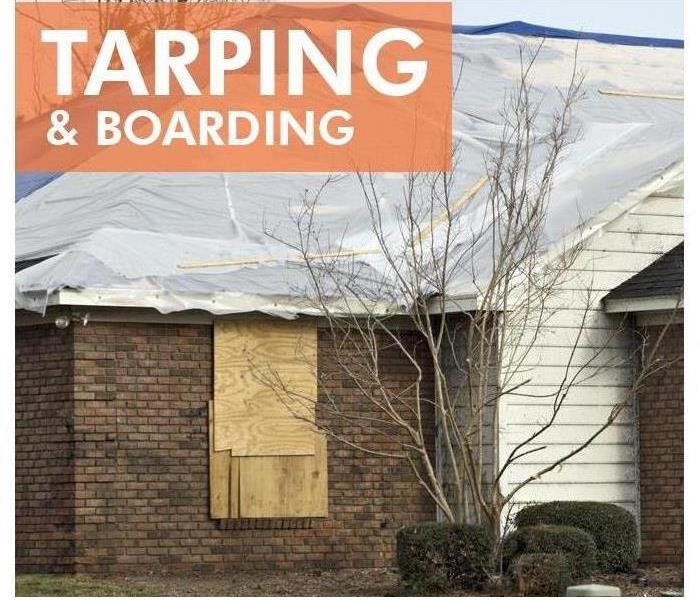 Restoration companies offer board-up, tarping and fencing services.
Restoration companies offer board-up, tarping and fencing services.
Residential Fire Restoration Process
The residual fire and smoke damage after a disaster and rescue efforts are likely one of the most devastating experiences of any homeowner's life. However, fire restoration companies exist to repair the seemingly irreparable. Regardless of the size of the property or home, every restoration effort follows the same necessary process.
- Securing the Property
The first step to getting your home back to normal is to secure the property. Most insurers require homeowners to mitigate further loss, which is why restoration companies offer board-up, tarping and fencing services. These companies make sure that no elements, natural or human, disturb your property or risk your coverage.
- Removing Water and Drying the Home
Another step in the mitigation process is removing any excess water from the rescue efforts. While it may be disheartening for homeowners not to see smoke damage be cleared away, every effort is made during these early stages to reduce liability concerns for insurers, making it easier for your claim to succeed.
- Cleaning and Removing Smoke and Soot Damage
After the mitigation work is done, the restoration company you have chosen will begin the process of debris removal and soot and smoke cleaning. Using specialized equipment and chemicals, these companies will clean the existing structure from top to bottom ensuring that all harmful residue is removed before moving on to the final phase.
- Restoration
Once a fire restoration specialist in the Saint Cloud, FL, area has performed all the necessary mitigation and cleaning, they will begin the process of actual restoration work. While some jobs are small enough for one company to handle, many professionals hire outside contractors to rebuild and restructure the home when necessary.
Fire and smoke damage might be extensive after a fire, and homeowners may feel like there is no hope for restoration. However, in the hands of experienced professionals, even the most devastating situation can be rectified.
Escaping a Fire
4/16/2020 (Permalink)
Causing more than 2,500 deaths and 12,600 injuries each year in the United States, house fires are extremely dangerous for those that are unprepared for the event. But they are preventable.
To be prepared should a fire occur in your home, it’s important to know what to do:
To ensure that your family remains safe throughout the ordeal.
It takes just two minutes for a fire to become life-threatening and just five minutes for a residence to become consumed by a fire. While the flames are what most people fear, that’s not what’s most dangerous as the heat and smoke do most of the damage. This is because the inhalation of extremely hot air can sear the lungs. A fire also has the ability to produce poisonous gases that can make you disoriented and drowsy making them all the more dangerous. In fact, the leading cause of fire deaths is asphyxiation which exceeds burns by a three to one ratio.
Preparing for a Fire
To make sure you’re prepared in the event of a fire, there are certain precautionary measures that must be taken to ensure your safety. The most important step is to create an evacuation plan for your family. Every second counts when a home is filling up with smoke so you need to know the fastest way out. Creating a plan and going over it with each member of your family will ensure that everyone can get out safely.
When developing your evacuation plan, make sure that you have two routes to escape each room in case one is blocked. Once your plan is formed, you should practice the plan at least twice a year. Being prepared for a potential fire means making sure that windows aren’t locked, screens can be taken out quickly, and that security bars can be opened. You should also have your family practice feeling around in the dark with their eyes closed replicating the environment they’ll be in if there’s a fire and teach the children not to hide from firefighters who are there to help.
The most important device to making sure you can safety escape a fire is a smoke alarm. Having working smoke alarms will significantly increase your chances of surviving the fire. To make sure that your smoke alarm will alert you of a fire in the home, test the batteries monthly, replace the batteries at least once a year, and replace the smoke alarm every eight to 10 years.
How to Escape a Fire
If a fire does occur in your home, you should escape the building as quickly as possible. However, there are some things you need to remember to safety evacuate. The first step is to get to the floor and crawl to the exit as heavy, toxic smoke and poisonous gases gather initiallly at the ceiling. When you get to a door, feel the doorknob and door before opening it. If either the doorknob or door is hot, you should leave it closed and go to your alternate way out. You should also leave the door closed if smoke is coming from around it. If you are able to open the door, do so slowly and be ready to shut it quickly should heavy smoke or fire be on the other side.
But what happens if you can’t get out? If the event occurs where you’re trapped in a room, cover the vents and cracks around any doors with cloth or tape to keep any smoke out. Then call the fire department and tell them where you are. You can use a light colored cloth or flashlight to get the attention of the firefighters. If you catch on fire yourself, simply stop, drop, and roll with your hands over your face to put yourself out.
If you’ve suffered a fire in your home rendering it uninhabitable and you have nowhere to go, contact your local disaster relief service like The Red Cross. If you have fire insurance, call the insurance company for details on protecting your property. You also should contact the professionals at SERVPRO of Osceola County to remediate the situation as soon as possible. The sooner they begin the restoration process, the more of your home and possessions will be salvaged.
A house fire is a devastating event that can lead to serious injury or death if you’re not properly prepared. These tips will ensure that you’re prepared for a fire and that you and your family can escape safely.
What To Do When Filing a Fire Insurance Claim
2/18/2020 (Permalink)
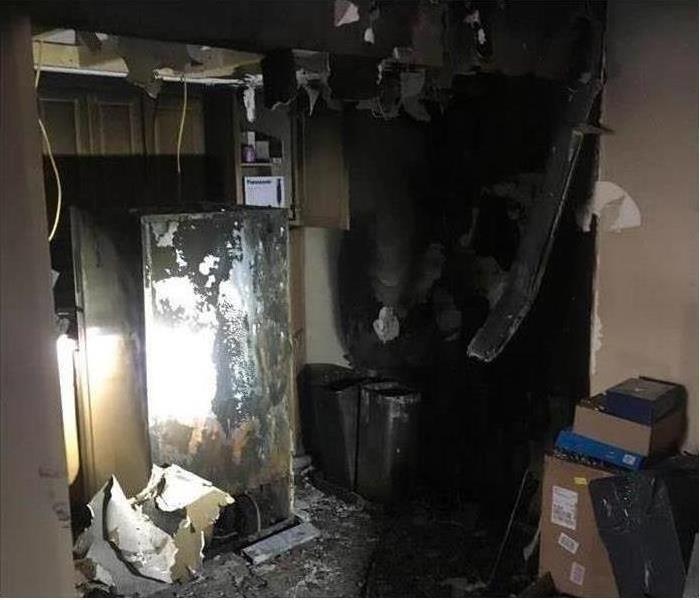 Kitchen fire in Celebration, FL
Kitchen fire in Celebration, FL
Steps to Take After You Have Experienced a Fire In Your Home
A fire can cause a lot of damage to your Celebration, FL home, and fire restoration can include a lot of cleanup and repairs. Fires are usually included in your homeowners insurance, so any damage to your house and property should be covered if you file a claim. Here are the steps you should take after you have experienced a fire in your home.
1. Call Your Insurance Agent
The first thing that you should do if your home has been damaged is call your agent to file a fire insurance claim. The sooner you do this, the better. It can take a while for your claim to be completed, so you don’t want to wait too long to begin. Depending on your policy, you may be required to submit your claim within a certain time period of the incident which is another reason that you should do so as soon as possible.
2. Document the Damage
In order for the insurance company to compensate you for anything that will need to be repaired during fire restoration, it is important that they know exactly what was damaged in the fire. Consider keeping a list of affected items and be sure not to throw anything away as it will serve as proof of the damage. Taking pictures of areas that need smoke cleaning might be helpful as well.
3. Take Steps To Prevent Further Damage
If you do not take proper care of your property and further damage occurs, the insurance company may not cover this. Calling a fire restoration company to help mitigate the property is a good idea. They can board up any damaged walls and windows as well as place tarps on missing roof areas.
In order to get the most from your fire insurance claim, you should be sure to file it as soon as possible after a fire has occurred. Keep track of lost and damaged items and do what you can to prevent more damage to make the process go more smoothly.
What To Do After You Suffer A House Fire
1/22/2020 (Permalink)
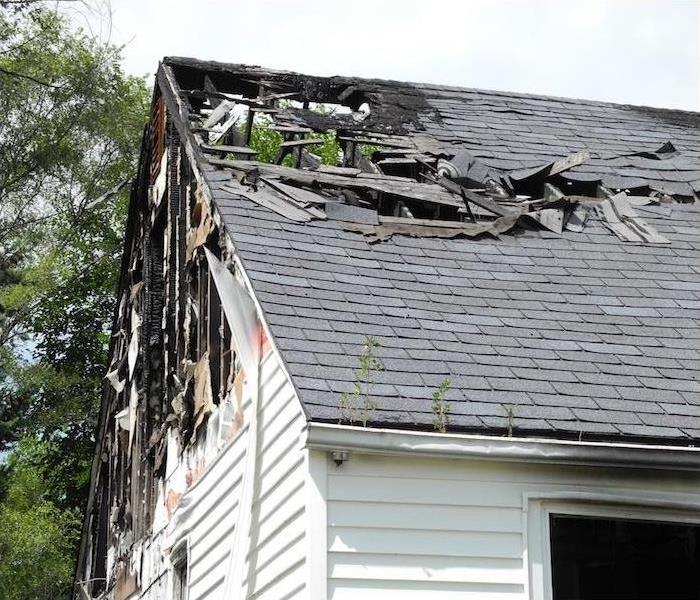 When a fire occurs in your home, it’s important to immediately call the professionals at SERVPRO to restore the building.
When a fire occurs in your home, it’s important to immediately call the professionals at SERVPRO to restore the building.
Suffering a fire in your Deer Park, FL home is one of the most traumatic events for a homeowner. You can potentially lose not only your home, but also your treasured possessions. To ensure that as many of your possessions can be saved as possible, you need to immediately contact the professionals at SERVPRO to restore the home.
The first step in restoring any home that has suffered from fire damage will be an inspection and fire assessment. This assessment is done often by both the restoration company and insurance company. The restoration company will determine what materials and equipment they will need to begin the restoration process. They do an inspection to determine how severe the damage is and whether or not it is safe to reenter the home. There are three steps that take place during the fire assessment process; an inspection of outdoor damage, an inspection of indoor damage, then the restoration of the home.
Inspecting Outside Damage
The first step during the fire assessment process that will be taken is an inspection of the outside of the home. During this inspection, the professional inspectors will be looking for any melted objects, missing roof shingles, damaged chimneys, or any other damage that has occurred to the outside of the home. Depending on the severity of the fire, they may also take a look around any surrounding yards, take a closer look at the roof, and look at any other exterior surfaces that might have incurred damage during the fire. The purpose of this inspection is to see whether or not there is any damage from the outside that is in need of repair.
Inspecting Inside Damage
Once the inspector has surveyed outside for any exterior damage, they will move inside to see what damage has been incurred inside the home, likely where the fire occurred. During this part of the inspection, the inspector will walk through the building looking for any visible damage. The main areas that are inspected are the walls, roof, , ceiling, floors, ducts, vents, bathtubs, sinks, and windows. Every room of the building must be inspected to make sure that all damage has been identified before the restoration process begins.
The main point of inspecting the inside of the house is to see what parts of the house are still intact and which parts of the house are falling apart due to the damage. During the inspection, the foundation, ceiling, and walls will be focused on as these are the parts of the home that can require the most significant restoration. This is because these parts of the house are largely responsible for the structural stability of the building.
Restoring the Home
Once the fire assessment has finished, the SERVPRO team will know the extent of the damage and what materials and equipment they need to complete the restoration process. The quicker the restoration of the building starts, the more of your possessions and the more of the building will be able to be restored.
One of the issues regarding fire damage restoration is water damage. When water is used to put out the fire, this creates water damage around the house. If the water is not properly cleaned up by professionals, mold and mildew are just a few of the problems that can arise. By immediately performing fire and water restoration, the professionals from SERVPRO will be able to salvage most of what could be lost if much more time is wasted. In the end, the goal of the process is to minimize the possibility of there being further damage.
When a fire occurs in your Poinciana, FL home, it’s important to immediately call the professionals at SERVPRO to restore the building. With the damage caused by the fire and the water damage caused by the water that puts out the fire, time is of the essence to avoid even worse damage being caused. The first step in the fire restoration process is a fire assessment, where the team will examine the inside and outside of the home to see how much damage has been caused and what materials and equipment will be needed in order to fully restore the home. So if you suffer from a fire in your home, call the professionals at SERVPRO for a full restoration.
How to Avoid a House Fire
1/9/2020 (Permalink)
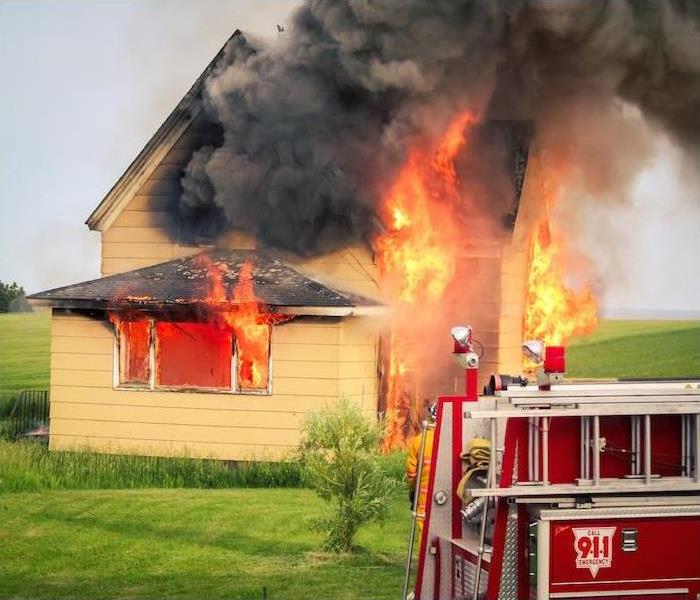 A house fire can be a traumatizing event but there are ways to prevent them.
A house fire can be a traumatizing event but there are ways to prevent them.
A house fire can be a devastating event for your home in Celebration, FL. You could potentially lose many of your possessions in addition to your home. While it may seem that some of these fires are unavoidable, there are ways that you can prevent these events from occurring. These are six of the most common causes of house fires and how you can prevent them.
Candles
A NFPA study found that between 2007-2011, an average of 10,630 fires were started by candles causing 115 deaths and 903 injuries. About $418 million worth of property damage was caused by these fires. One-third of these fires were started in the bedroom which were 39 percent of associated deaths and 45 percent of associated injuries.
There are several causes of candle-related house fires. More than half of the fires that were started in the bedroom were because open flames were left too close to flammable items. Other causes of these fires include leaving the room unattended, someone playing with the candles, and the candle knocking over when someone or a pet bumps the table.
To avoid candle related house fires, keep any candles 12 inches away from any flammable items, never leave a candle lit in a child’s room or an unoccupied room, make sure the candle fits securely into the candle holder so it won’t tip over, and blow out any candles before leaving a room or going to sleep.
Smoking
According the NFPA, 17,600 house fires are a result of smoking. That’s resulted in 490 deaths and more than $516 million in property damage. In 2013, the NFPA found that there had been a 73 percent drop in smoking-related house fires from 2008-2011 mostly due to a decrease in the number of smokers. Also helping the drop in smoking-related house fires were new regulations creating non-flammable mattresses, clothing, and furnishings.
The causes of these types of fires are usually ashes or cigarette butts not being completely put out, smoking near a medical oxygen tank, or lacking attention to the cigarette due to falling asleep, drinking, or taking medication while the cigarette is lit.
To avoid causing a smoking-related house fire, smoke outside, use wide and sturdy ashtrays to catch all butts and ashes, and be aware of any cigarettes that may have fallen under furniture or between seat cushions. Also make sure that there are no lit butts that have fallen where they can’t be seen.
Electrical and Lighting
The NFPA reports that in 2011, approximately 47,700 house fires were caused by an electrical failure or malfunction of some sort. These types of fires resulted in 418 deaths, 1,570 injuries, and caused $1.4 billion worth of property damage.
Causes of electrical and lighting fires include equipment malfunction, an overloaded circuit or extension cord, an overheated light bulb, a space heater, a washer, and a dryer. Of all the fires caused by electrical and lighting between 2007-2011, 63 percent were due to wiring problems.
Ways that you can avoid starting an electrical or lighting fire include not overloading outlets or electrical cords, ensuring you’re using the right cords (inside cord for inside and heavy duty or outside cord for outside), not leaving Christmas equipment (lights and trees) on overnight or when you’re not home, and having an electrician perform an annual checkup on the home’s wiring.
Dryer and Washing Machines
The NFPA found that 16,800 house fires in 2010 were caused by dryers and washing machines resulting in more than $236 million worth of property damage. Of the fires started by dryers, 29 percent were caused by lint or dust and 28 percent were caused by clothing. For washer-related fires, 26 percent were caused by wire or cable insulation, 21 percent caused by appliance housing, and 15 percent were caused by the drive belt.
Tips to avoiding these types of fires include cleaning the lint screen frequently, ensure there are no leaks in the lines in gas or propane dryers, ensuring the dryer is vented to the outside of the house so that nothing blocks the vent pipe, clean the vent pipe and area where the screen is housed, and keep the area around the dryer free of combustible materials.
Lightning
The NFPA says that from 2007-2011, an average of 22,600 house fires were started annually from lightning. These fires are different than the others on this list as they were primarily started during the summer months of June, July, and August rather than December and January.
To avoid lightning-related fires, stay away from doors or windows during an electrical storm, don’t use corded electrical equipment during storms, unplug major electronics when lightning is close by, and avoid plumbing fixtures like sinks or baths during a thunderstorm.
Cooking
Nearly 40 percent of all house fires are started from cooking. That 156,000 house fires per year and they have caused $853 million worth of property damage. Two-thirds of these fires start due to food or other materials catching fire with 57 percent of these fires starting on a range and 16 percent of these fires being caused by an oven. These fires are typically started either when grease is left unattended or when frying something.
To prevent the possibility of a house fire in your Reunion, FL home when cooking, don’t leave your food unattended, don’t attempt to put out a grease fire with water instead putting a lid on the pan to smother it, keep items away from the heat source, and make sure your smoke detectors work and there is a fire extinguisher nearby. If a fire occurs in the oven, shut the door and wait for it to extinguish itself.
A house fire can be a traumatizing event but there are ways to prevent them. By knowing what causes these fires and understanding safety measures, you can ensure you won’t suffer this fate. If you do suffer a house fire, call SERVPRO to remediate the problem.
Effective Ways to Prepare an Emergency Home Escape Plan
10/12/2019 (Permalink)
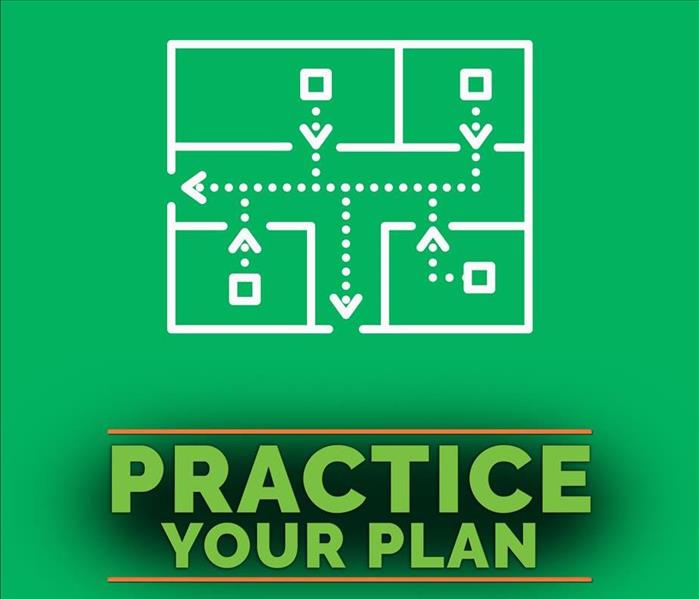 Go through your fire escape plan as a family at least once a year
Go through your fire escape plan as a family at least once a year
No one likes to think about dealing with a disaster or emergency situation at home. The results could be disastrous for you, your family members and your house. Fortunately, you can increase the likelihood of your safety and well-being when you have an efficient fire escape plan. It’s too late to come up with a strategy during the event, so make sure you’re proactive and devise a plan today.
Identify the Exits
In a house fire, you may not have a lot of time to deliberate where to go and how to get out. It’s vital to be aware of the closest ways to exit your home, whether it be through a window or door. Make sure everyone in your home knows how to open windows and how to safely get out of second-story rooms.
Know Fire Safety
Most people learned in grade school some basic skills of how to react to house fires. Review this part of the emergency escape plan with your family. Some important elements include staying below the smoke level and feeling doors to measure the heat before exiting a room.
Have a Designated Meeting Place
Even small fires in your Poinciana, FL, home can turn deadly. It’s crucial to leave the home as quickly as possible and have a predetermined spot to meet outside. Ensure that everyone in your household knows this. Select a place far enough away from your home that you will be safe from flames and smoke.
Practice
Go through your fire escape plan as a family at least once a year. Role-play the situation so that if the real thing occurs, you won’t panic or be confused.
A fire escape plan isn’t difficult to come up with, but it could save your life someday. Firefighters and professional fire cleanup crews will do their job. Make sure you do yours by getting out alive.
Stay Fire-Free this Holiday
12/4/2017 (Permalink)
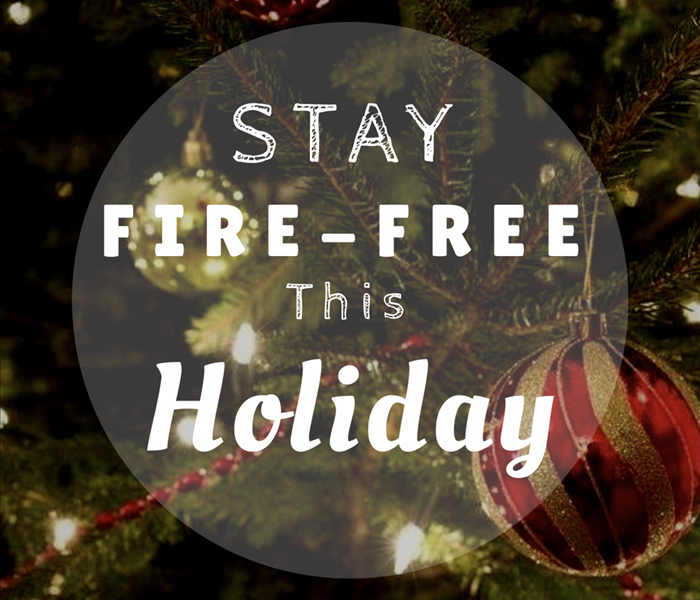 Ensure your family's safety this holiday by following these recommendations of a fire-free December!
Ensure your family's safety this holiday by following these recommendations of a fire-free December!
This Fall season in Florida has brought us cooler temperatures, amazing weather, and an abundance of outdoor activities. You can help make sure your seasonal plans don’t go up in smoke by taking a few precautions. Keep your family safe and fire-free by planning ahead this season.
Fall Decorations
Decorations like flowers, wreaths, and Christmas trees are likely to dry out and are very flammable. Keep these and other decorations away from open flames and heat sources, including light bulbs and heaters.
Emergency Exits
While celebrating these Holidays, be sure to keep all decorations clear from any emergency exits, whether that’s a window or a back door. Nothing should be blocking an escape route.
Bon Fires
Though Florida isn’t known to have many bon fires, they still occur on those rare cold nights either on the beach or in a backyard. Teach your children to stay away from open flames. Be sure they know how to stop, drop, and roll if their clothing catches fire.
Candles/ Lanterns
If you’re like me as soon as December arrives, my seasonal and holiday candles are out and lit! But even adults should use caution using real candles. Ensure that nothing flammable is close to the candle before lighting, such as paper, linens, and decorations.
Locally Owned, with National Resources
SERVPRO of Osceola County is locally owned and operated so we are part of the Celebration and Harmony, Florida community too. When you have a fire, flooding or water emergency, we’re already nearby and ready to help. As fire and water damage specialists, we have the experience, the expertise, and the advanced training that enables us to get your property restored quickly and thoroughly. Please call (407) 933-0707




 24/7 Emergency Service
24/7 Emergency Service






